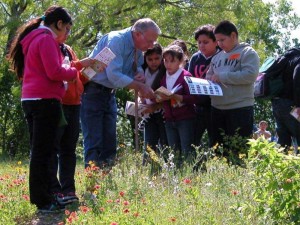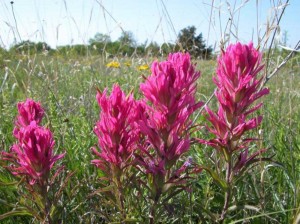The new buzz about saving prairies sounds like the sweet song of a scissor-tailed flycatcher to Don Young, who’s an old hand at protecting native lands. He founded the nonprofit Friends of Tandy Hills Natural Area a decade ago to conserve and restore the rare, city-owned 160-acre plot of native prairie just a few miles east of downtown. His concern was natural –– Young and his wife, Debora, live across the street from it.
They wanted to protect the natural area (and their own property values) from gas drillers hungrily eyeing the property. But they also had to convince city officials to do the controlled burns, chainsaw work, and cleanups that would keep the trees out. And they wanted to get kids interested in the prairie via field trips. Those activities led to the creation of Prairie Fest, a unique festival that would help promote Friends as well as the importance of prairies. The free event debuted in 2006 with a couple hundred people hanging out at the Youngs’ house. Now Prairie Fest attracts thousands of people each year to celebrate the outdoors, take wildflower tours and science hikes, and listen to musical acts playing on a sound system powered by the sun.

However, the Youngs are now trying to pave the way for a new generation of environmental activists and prairie-lovers. Don and Debora have stepped down as directors of Prairie Fest, passing their roles onto James Zametz — founder of Keep Fort Worth Funky, an organization that supports local innovation and helps host events like the upcoming Clearfork Music Festival — and graphic designer Jen Schultes. Both will act as directors of the 10th anniversary of Prairie Fest in 2015.
Young contributed to the recent State of the Prairie Conference by leading a group of people from all over the state on a tour of Tandy Hills, planting seeds that he hopes will blossom into protected prairies in other areas.
“I gave a talk about how my organization has been able to engage the public in caring about prairies and doing things about it and also how we use social media and our festival, among other things, to get people really interested in prairies,” he said.
The theme of this year’s prairie conference was “Prairies in a Changing World.” Since this “Changing World” includes the widespread ravages of the drilling industry, the title was a huge understatement.
“That’s really what started our organization, a concern about drilling and a determination to keep it out,” Young said.
Young’s organization has come a long way. In the beginning, he and city employees had a contentious relationship as he demanded more and more conservation and maintenance on a property that was given to the city by a generous benefactor in the 1960s and then mostly forgotten. This year, Young’s group received a proclamation from the mayor recognizing their work. The city has also provided funding to carry out the group’s master plan for protecting, enhancing, and conserving Tandy Hills.
“It’s a long-range plan focused on things that make Tandy Hills special, because 99 percent of all prairie is gone,” Young said. “This is sort of like a little relic, a museum of what it used to be.”
He likened a prairie to a rainforest, with diversity in plants and animals and in need of the same level of protection. Other than the threats resulting from human civilization, land is also susceptible to natural threats, such as invasive species. The No. 1 problem is trees overtaking a prairie, Young said.
“A big part of the master plan is controlling and keeping the trees out, because a prairie is about grass and wildflowers,” he said. “That’s what grows here. That’s what makes a prairie a prairie. Too many trees take that out, and you lose it.”
Controlled burns can be used to preserve a prairie.
“Controlled burns are a pretty serious deal,” he said. “It’s going on at the Nature Center, and we’re working hard to have that happen here at Tandy Hills. People tend to get jittery about fires, controlled or not, burning close to their homes, so conserving pocket prairies in urban areas can be challenging.”
Fire, Villafranca said, is vital to prairie maintenance: “But now that we’ve pretty much settled the prairie, people aren’t too excited about wildfires.”
Although alternative methods such as haying or mowing can be used in areas surrounded by subdivisions, the Wildflower Center in Austin started a controlled burn program near urban areas and has overseen several successful burns without incident.
“In the future, we might be able to do more of that,” Villafranca said.
********
In addition to keeping out invasive species and trees through the use of controlled fires, conservationists are trying to keep developers at bay. A high-profile example in these parts is the long battle fought by the Great Plains Restoration Council to save the Fort Worth Prairie Park.
As if the toll road wasn’t a big enough blow, the state recently sold most of the rest of the land to a development group. The Walton Group of Companies purchased 1,755 acres from the Texas General Land Office in June.

The 27-mile toll road creates prime-frontage real estate for commercial companies. Jim Sudyam, press secretary for the General Land Office, said the toll road increases the value of the land, which the agency purchased in 2005 with the intent to sell.
“It’s an attractive piece of property,” he said. “That’s why we bought it.”
Shortly after the state purchased the property, Manos and the Great Plains Restoration Council began lobbying Texas Land Commissioner Jerry Patterson to save the prairie and turn it into a protected park. But Manos could never come up with enough donors to fund a purchase.
“The land office had waited a substantial amount of time for preservation efforts to materialize, and they never really did,” Sudyam said.
The agency operates with profits in mind, as land sales benefit the state’s Permanent School Fund. Conservation is rarely a deciding factor.
“We are not the parks department,” Sudyam said.
The Walton Group bought another 268 acres near the Chisholm Trail Parkway this month, which is slated for a planned community known as Chisholm Trail Ranch. Walton outlined plans to build about 1,000 single-family homes there, as well as an elementary school, in the Crowley school district. The company is talking with builders about construction plans to be decided by the end of 2015, according to a recent company statement.
As for the prairie land purchased in June, John Vick, Walton’s South Central Regional President, said the planning process is under way.
“Initial steps include meeting with local elected officials and the City of Fort Worth Planning Department and receiving input from surrounding property owners,” he said. “Once we have developed a vision for the property, we will be able to share that with local stakeholders for their feedback.”
However, Walton Global Investments CEO Bill Doherty told the Fort Worth Star-Telegram that it could be four years before construction begins.
So all the environmentalists threw up their hands, accepted defeat, and went home. The end.
If you believe that, you don’t know the heart of an activist.
********












It’s inspiring to see more and more younger crowds come out to Prairie Fest at Tandy Hills Nature Area every year. It shows that people still do care about nature and realize that we have to have that connection to the world outside of the concrete jungle. Keep Fort Worth Funky is proud to be partners with Tandy Hills and we hope to carry the tradition of conservation and education for the next generations. Bravo!
It’s inspiring to see more and more younger crowds come out to Prairie Fest at Tandy Hills Nature Area every year. It shows that people still do care about nature and realize that we have to have that connection to the world outside of the concrete jungle. Keep Fort Worth Funky is proud to be partners
It’s inspiring to see more and more younger crowds come out to Prairie Fest at Tandy Hills Nature Area every year. It shows that people still do care about nature and realize that we have to have that connection to the world outside of the concrete jungle.
It’s inspiring to see more and more younger crowds come out to Prairie Fest at Tandy Hills Nature Area every year. It shows that people still do care.
It’s inspiring to see more and more younger crowds come out to Prairie Fest at Tandy Hills Nature Area every year.
Kudos and big thanks to Nicole, Melissa and Jeff. Very well researched and written report. One minor correction: Tandy Hills was not a gift to Fort Worth. It was purchased in 1960 for $138,250. You can read about that here: http://tandyhills.org/news/happy-54th-bearthday-tandy-hills
Don’t miss a chance to help launch a local movement saving prairies. The first official meeting of the Fort Worth Chapter of Native Prairies Association of Texas (NPAT) happens Monday, August 11. Your ideas are welcome and needed! There will also be a brief presentation on Conservation Easements.
Learn more about NPAT here: http://texasprairie.org/index.php/learn/
What: New Native Prairies Chapter forming
When: August 11, 2014 – 6:30 to 8:00 PM
Where: 8700 Chapin Road, Fort Worth, TX 76116
Why we care: Prairie Keepers is a prairie education and advocacy group based in North Texas. We lead hikes at Prairie Fest – the only solar powered music and prairie wildflower festival in Texas. Here’s a map the Tandy Hills Natural Area and a place to sign up to lead hikes at the 10th annual fest –
http://www.volunteermatch.org/search/opp1594366.jsp
Prairie Keepers thanks FW Weekly for this informative and well researched article!